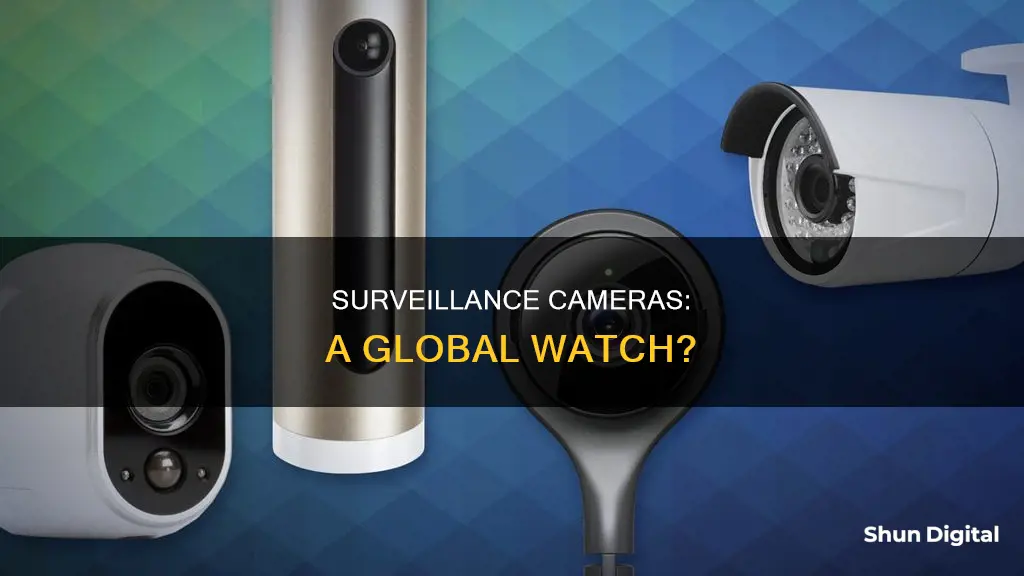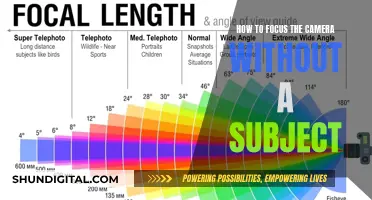
Surveillance cameras are everywhere. In 2015, the global video surveillance industry was valued at about $20 billion, and that number is expected to grow to $63.2 billion by 2022. With the rise of new technologies, surveillance cameras are becoming more and more accessible to the public. Websites such as Insecam allow anyone to view thousands of live security cameras from all over the world. While some may argue that this increases transparency and can help to deter and solve crimes, others argue that it is a breach of privacy and can be used for more nefarious purposes.
| Characteristics | Values |
|---|---|
| Purpose | Crime prevention, traffic monitoring, observing industrial operations, law enforcement, etc. |
| Number of Surveillance Cameras | Estimated 1 billion surveillance cameras worldwide by the end of 2021 |
| Most Surveilled Cities | Cities in China, Hyderabad, Indore, Delhi, Singapore, Moscow, Baghdad, Seoul, St. Petersburg, London, Los Angeles |
| Surveillance Camera Websites | Insecam, EarthCam, Live Beach, New York Traffic Cameras |
What You'll Learn

China: 9/10 most surveilled cities, 1 camera per 4.1 people
When it comes to global surveillance, China stands out for its extensive network of cameras and its use of advanced technologies to monitor its citizens. A recent report by Comparitech ranked cities worldwide based on the number of CCTV cameras and the country's track record on privacy and data protection. The results show that China dominates the list, with nine out of the top ten most surveilled cities located in the country.
The report estimates that there is one surveillance camera for every 4.1 people in China, an astonishing ratio that far surpasses any other country. This dense network of cameras covers major cities, with Chongqing, Shenzhen, and Dongguan taking the top three spots globally. These cities are estimated to have over 2.5 million cameras each, providing near-comprehensive coverage of public spaces. Other Chinese cities in the top ten include Shanghai, Beijing, Guangzhou, Zhengzhou, Xi'an, and Shijiazhuang.
The Chinese government justifies this extensive surveillance network as a necessary tool for maintaining social stability and public security. Facial recognition technology is widely deployed, enabling authorities to identify and track individuals in real time. This technology has been used for various purposes, including crime prevention, traffic management, and even monitoring student attendance and behavior in schools. However, human rights organizations have raised concerns about the potential for misuse and abuse of this technology, particularly against minority groups and dissidents.
The lack of strong privacy laws in China further exacerbates these concerns. The country's Cybersecurity Law grants broad powers to the government to access and use personal data. Without adequate legal protections, there are few safeguards to prevent the misuse of surveillance data or ensure transparency and accountability in how it is collected and used. As China continues to invest in its surveillance infrastructure and develop new technologies, the implications for privacy and freedom will continue to be a subject of global concern.
Tennessee Camera Tickets: What Happens if You Don't Pay?
You may want to see also

London: Most surveilled city in Europe, 627,727 cameras
London: The Most Surveilled City in Europe
With an estimated total of 627,727 cameras keeping a watchful eye across the city, London has earned the title of the most surveilled city in all of Europe. This vast network of cameras covers a wide range of locations, from busy streets and public transit hubs to iconic landmarks and tourist hotspots. The sheer number of cameras in operation means that an average Londoner could be captured on camera over 300 times a day.
The presence of such an extensive surveillance system has sparked debates around privacy and security. While some argue that the cameras are an invasion of privacy and a potential tool for mass surveillance, others view them as a necessary measure to ensure public safety and combat crime. The cameras are operated by a mix of government agencies, transportation authorities, and private businesses, each with their own specific purposes and objectives.
One of the key justifications for the extensive camera network is to deter and prevent crime. The London Metropolitan Police, for example, utilizes a large portion of these cameras to monitor and respond to criminal activities. The widespread use of CCTV (closed-circuit television) cameras has been linked to a reduction in certain types of crimes, providing valuable evidence and helping to identify and apprehend suspects.
However, the effectiveness of this extensive surveillance system has been questioned. Critics argue that the vast majority of cameras are operated by private entities, with an emphasis on protecting private property rather than preventing public crimes. There are also concerns about the potential for misuse or abuse of the footage captured, especially with the rapid advancements in facial recognition technology.
Despite the debates, the number of surveillance cameras in London continues to grow, with new technologies and strategies being implemented to enhance their capabilities. The city's extensive camera network has become an integral part of its security infrastructure, shaping the daily lives and experiences of both residents and visitors alike.
This response provides a detailed overview of London's status as the most surveilled city in Europe, discussing the reasons behind the extensive camera network, the potential benefits and drawbacks, and the ongoing debates surrounding privacy and security.
Overnight Charging: Is It Damaging Your Camera Battery?
You may want to see also

New York: 18,000 cameras, 2.2 cameras per 1,000 people
New York City has an extensive network of surveillance cameras, with an estimated 18,000 police CCTV systems and many other cameras in use across the city. This equates to approximately 2.2 cameras for every 1,000 people, making New York one of the most surveilled cities in the world outside of China.
The presence of so many cameras means that residents and visitors to New York are constantly being watched. A survey by Amnesty International and volunteers found over 15,000 surveillance cameras in just three of the city's five boroughs: Manhattan, Brooklyn, and the Bronx. Brooklyn is the most surveilled borough, with over 8,000 cameras. New York City's surveillance network is so advanced that it can even detect things like an unattended bag.
The New York Police Department (NYPD) has access to many of these cameras and can use them for facial recognition searches. This technology is controversial as it is known to amplify racially discriminatory policing and threaten the rights to freedom of peaceful assembly and privacy. According to NYPD documents, the department has used facial recognition technology in almost 22,000 searches since 2017.
While the use of surveillance cameras by law enforcement may raise concerns about privacy and civil liberties, it is important to note that there are laws in place in New York that govern the use of such technology. For example, the Public Oversight of Surveillance Technology (POST) Act, passed in 2020, requires the NYPD to disclose the types of surveillance being used, the procedures in place to protect against abuse, and the oversight mechanisms to protect citizens' privacy.
In addition to police surveillance cameras, there are also many private security cameras in New York, installed by businesses and homeowners. This further contributes to the high level of surveillance in the city.
Alternative Ways to Charge Your GH2 Camera
You may want to see also

Los Angeles: 40,000 cameras, 6.9 cameras per 1,000 people
Los Angeles is one of the most surveilled cities in the world. With 40,000 cameras monitoring 3,769,485 people, that's 6.9 cameras per 1,000 people or approximately 1 camera for every 140 people. This is a conservative estimate, as some sources place the number of cameras in Los Angeles at 35,000 or 39,790.
The city's extensive surveillance network includes fixed CCTV cameras, real-time crime center cameras, private cameras within the police force's network, police body cameras, patrol car dash cameras, cameras on public transport, and traffic cameras. The Los Angeles Police Department (LAPD) is also seeking to expand its access to surveillance footage through its new program, LAPD Live. This program aims to centralize live video feeds from security cameras across the city, including private homeowner cameras, with the goal of having access to 10,000 cameras in the coming years.
The high level of surveillance in Los Angeles has sparked debates about the balance between public safety and privacy. Proponents of the cameras argue that they serve as a deterrent to crime and an invaluable tool for solving crimes, while critics argue that they invade privacy and can be used to target certain communities, such as Black and Latino individuals, for increased surveillance and policing.
While there is some concern about the potential for abuse or over-reach, the presence of so many surveillance cameras in Los Angeles undoubtedly means that anyone visiting or living in the city is likely to be captured on camera numerous times a day. This level of surveillance has implications for privacy and civil liberties, with some arguing that it could lead to a "stalker state" or a "police state".
Los Angeles is not alone in its extensive use of surveillance cameras. Other US cities with high numbers of cameras include Atlanta, Washington, DC, New York City, and Chicago. Globally, cities in China have the heaviest CCTV surveillance, with an estimated 626 million cameras across the country.
Mastering Xbox One Camera Modes: A Quick Guide
You may want to see also

Moscow: 203,600 cameras, 7.5 cameras per 1,000 people
Moscow's Extensive Surveillance Network
As of 2023, Moscow has an extensive network of approximately 203,600 surveillance cameras keeping a watchful eye on the city. That equates to a significant density of 7.5 cameras for every 1,000 people in the Russian capital. This dense network of cameras provides an insightful case study on urban surveillance and its implications for privacy and security.
The Moscow surveillance system is a complex and integrated network, with cameras varying in type and purpose. These range from basic CCTV cameras to more advanced systems with facial recognition and number plate reading capabilities. The majority of cameras are owned and operated by the city's Department of Information Technology, which provides an extensive coverage of the city's public spaces, including streets, parks, and transportation hubs.
This dense camera network allows for a high level of monitoring and has been utilized for a range of purposes. Beyond basic crime prevention and detection, the system has been employed to manage traffic flow, detect and respond to emergencies, and even monitor the city's infrastructure for maintenance needs. The system has also been used to enforce COVID-19 restrictions, such as tracking quarantine compliance and ensuring social distancing in public spaces.
While the benefits of such an extensive surveillance system are clear, there are also concerns surrounding privacy and data protection. Moscow's system has faced criticism for its potential to infringe on civil liberties, with the potential for misuse or abuse of the extensive data collected. The system's effectiveness is also dependent on proper regulation and oversight, with the potential for misuse or abuse of power if not properly managed and transparent.
Despite these concerns, the Moscow model provides an interesting insight into the future of urban surveillance and the potential for technology to shape how cities are managed and secured. The balance between security and privacy will continue to be a key consideration as camera technology becomes even more advanced and integrated into our daily lives.
Choosing the Right Camera Battery: Maximizing Power
You may want to see also
Frequently asked questions
It is difficult to give an exact number, but there are estimated to be over 1 billion surveillance cameras worldwide as of 2021.
China has the heaviest CCTV surveillance in the world, with around 600 million cameras within its Skynet project. This equates to almost one camera for every two people.
Websites such as EarthCam, Insecam, and Live Beach offer access to thousands of live surveillance cameras from around the world, in both public and private places.
Yes, the increased use of surveillance cameras has raised concerns about individual privacy and civil liberties. There is also a debate about the effectiveness of CCTV in preventing crime.







